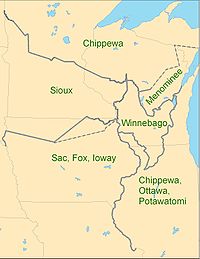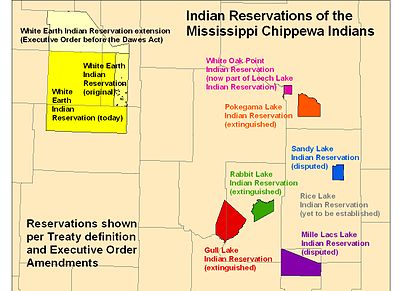- Mississippi River Band of Chippewa Indians
-
Mississippi River Band of Chippewa Indians (Anishinaabe: Gichi-ziibiwininiwag) or simply the Mississippi Chippewa, are a historical Ojibwa Band inhabiting the head-waters of the Mississippi River and its tributaries.
According to oral history of the Mississippi Chippewa, they were primarily of the southern branch of Ojibwe who spread from the "Fifth Stopping Place" of Baawiting (Sault Ste. Marie region) along Lake Superior's southern shores until arriving at the "Sixth Stopping Place" of the St. Louis River, and then continued westward across the Savanna Portage, and spread both northward and southward along the Mississippi River and its major tributaries.
Before entering the treaty process with the United States, the Mississippi Chippewa consisted of the following sub-bands:
- Crow Wing Band
- Gull Lake Band
- Mille Lacs Band
- Pelican Lake Band
- Pokegama Lake Band
- Rabbit Lake Band
- Rice Lake Band
- Sandy Lake Band
- Snake River Band
- Swan River Band
- Trout Lake
- White Oak Point Band
and many villages associated with these sub-bands. Together, they controlled the main north-south trade corridor of the Mississippi River headwaters.
In 1825, with the Treaty of Prairie du Chien, United States drew the Prairie du Chien Line to separate the Ojibwe from the Dakota, believing the two were still fiercely at war with each other, though the Ojibwe and the Dakota had ended their war for nearly a generation and only experienced infrequent skirmishes.
The Mississippi Chippewa, along with the Red Lake Band, Pillager Band and the Lake Superior Band, entered into the Treaty of St. Peters in 1837, ceding to the United States what now is part of northern Wisconsin and east-central Minnesota.
In 1850, the annuity distribution was changed from La Pointe, Wisconsin to Sandy Lake, causing mass death of the Ojibwa camped there with poor or inadequate provisions.
In 1855, fueled by the tragedy at Sandy Lake, the Mississippi Chippewa, along with the Pillager Band of Chippewa Indians, agreed upon the Treaty of Washington for the land cession in most of northern Minnesota. In exchange, three reservations were promised for the Pillagers and six reservations were promised for the Mississippi Chippewa. The six reservations being:
- Gull Lake Indian Reservation
- Mille Lac Indians Reservation
- Pokegama Lake Indian Reservation
- Sandy Lake Indian Reservation
- Rabbit Lake Indian Reservation
- Rice Lake Indian Reservation
However, due to confusing records kept by the U.S. Bureau of Land Management, the Rice Lake Indian Reservation was never established. At the heart of the issue was several different lakes about Sandy Lake, when translated into English, were all named "Rice Lake." Depending on which map was cited, Rice Lake Indian Reservation was either located fully within the boundaries of the Sandy Lake Indian Reservation on its north end, or was adjacent to the Sandy Lake Indian Reservation on its south end; and depending on the map showing the Rice Lake Indian Reservation adjacent to the Sandy Lake Indian Reservation, some showed the Rice Lake Indian Reservation to the southeastern corner on the eastern edge of Sandy Lake Indian Reservation, yet on other maps showed the Rice Lake Indian Reservation on the southeastern corner on the southern edge of Sandy Lake Indian Reservation. However, the Rice Lake Band claimed these representations were all incorrect and the proper location of the agreed Rice Lake Indian Reservation was much farther south.
With the Dakota War of 1862, many Chippewa Bands aided the Dakota people. Sandy Lake Band remained fully neutral with this conflict. However, when Mille Lacs Indians Chief Máza-mani (Iron-Walker) learned of the plans of Gull Lake Band Chief Bagone-giizhig (Hole-in-the-Day) to attack Fort Ripley, Chief Máza-mani raised a party of 200 men and they set out to aid the Fort in advance of Chief Bagone-giizhig, thus adverting Chief Bagone-giizhig's attack onto the Fort. Both Sandy Lake and Mille Lacs Bands gained protection from the United States, while all other Mississippi Chippewa were forcibly removed off their reservations to the area surrounding the Leech Lake and Lake Winnibigoshish Indian Reservations.
Due to strife between the removed Mississippi Chippewa with the Leech Lake Pillager Band and the Lake Winnibigoshish Band, the Mississippi Chippewa again negotiated with the United States for resettlement. The Lake Pokegama Band negotiated to remain in the area and eventually formed the White Oak Point Reservation which in 1934 merged with the Cass Lake, Chippewa, Lake Winnibigoshish and Leech Lake Indian Reservations to form the contemporary Leech Lake Band of Ojibwe and its reservation. The remaining Mississippi Chippewa agreed to resettlement to the west, forming the contemporary White Earth Band of Chippewa. The United States, under the pressures from lumbermen and farm settlers, saw the White Earth Reservation as the answer to the "Chippewa Problem" and strongly pressured the Mille Lacs and Sandy Lake Bands to relocate there. Many did, becoming the "Removable" while those who remained became the "Non-removable".
Though the Mississippi River Band of Chippewa Indians no longer exists today, majority of Mille Lacs Band of Ojibwe and White Earth Band of Chippewa still identify themselves as a Mississippi Chippewa. Successors apparent of the Mississippi Chippewa are:
- Leech Lake Band of Ojibwe
- Mille Lacs Band of Ojibwe
- White Earth Band of Chippewa
References
- Warren, William W. History of the Ojibway People. Borealis Books (St. Paul, MN: 1984).
- Wedll, Joycelyn. Against the Tide of American History: The Story of Mille Lacs Anishinabe. Minnesota Chippewa Tribe (Cass Lake, MN: 1985).
External links
Categories:- Ojibwe
- Native American tribes in Minnesota
Wikimedia Foundation. 2010.


